Need $1,000 right now? You’re not alone: Here’s why — and how to get it.

If you’re feeling strapped for cash, you’re in the majority. More than 60% of Americans said they couldn’t come up with at least $1,000 in the event of an emergency, according to a recent survey from the personal finance site Bankrate — not even enough to cover a hospital visit or a broken transmission.
For some, recent splurging hasn’t helped matters: Another new survey from LendEdu found that the average credit card balance swelled nearly $1,000 as a result of holiday spending last year. While a lot of those consumers said they had expected to be in the red for a little while in 2018, more than half of those surveyed said the new debt was stressing them out.
And you probably already work hard, which makes it tough to prioritize building an emergency fund or paying off debt — when you are also trying enjoy your life. Indeed, taking a nice vacation narrowly edged out paying off credit card debt in a recent survey about 2018 financial priorities from the personal finance site Credit Sesame. Before last summer, MagnifyMoney reported that more than one in five Americans planned to borrow money for a vacation, an “alarming” figure.
To be sure, everyone needs to take some time off to recharge — studies even show that vacations make us more productive and correlate with raises — but the stress-relieving benefits of that vacation are sure to be short-lived if a new pile of debt is waiting for you when you get home.
Need help? Here’s how to put together $1,000 quickly — and then actually keep it around so it’s not gone when you need it — in three simple steps.
1. Make or save money super quickly
First, get creative. Consider a flexible side-hustle like dog-walking — or an unusual moneymaker like selling your old gadgets, hair or poop (actually). Look into 10-minute cash-earning hacks, methods of earning passive income, and other surprising tricks to find money you didn’t know about.
But also be ready to do more than just add cash to your bottom line: Prepare to “subtract” less of it, too. That means auditing your budget (you have one, right?) for opportunities to trim spending without feeling the pain.
Start with the biggest expenses like housing — can you get a roommate? sign up for Airbnb? — and work your way down with a special eye for expenses you can cut easily or which shouldn’t be there in the first place.
Apps like Trim can help you find tricky recurring expenses that you’re not using; and even cable companies are sometimes willing to negotiate if you pick up the phone and make a case for lowering your bill.
You also might be able to save a few bucks by bundling your insurance with a single provider, or taking a hard look at your cell phone and wireless plan. And if you can, stop buying brand name products instead of generic alternatives: Mic estimates that this alone could save you $1,500 each year.
2. Create your emergency fund
Once you have a little cash in hand, resist the urge to spend it — and instead pull the trigger and open a savings account.
The typical rule of thumb is that an emergency fund should have about three to six months of expenses in it. That’s a pretty big range, to be sure, which is why it may be a good idea to use a cost of living calculator to get a more specific amount. By stashing your savings in a high-yield savings account, you can also count on that stash to grow the longer you leave it untouched.
One helpful move? Give your emergency fund a name, since people are better at saving for specific expenses than abstract, far-away goals like retirement. And know that you likely tend to prioritize what you can enjoy immediately, a phenomenon known as temporal discounting. So trick yourself into long-term thinking by setting up small but automated deposits.
3. If you have to borrow — have a plan
Of course, drumming up quick cash or trimming your budget is only going to get you so far during a serious emergency. The problem is — though there are a range of services willing to lend you money in the short term — many such products are predatory and can leave you in an even worse position.
Most people who can’t cover an emergency expense with their savings put it on a credit card, according to Bankrate’s data. That may be fine, unless your balance is already high. Credit cards also often carry higher interest rates than a personal loan you might qualify for from a non-profit credit union or other reputable lender.
One way to get around the problem of interest payments? Many credit cards come with long introductory periods where you’re not paying any interest on the debt you’ve accrued. By getting a good balance transfer card, you can move your debts into a single place, and keep the debt from snowballing as you take the time to pay it off.
Still, the main drawback to a balance transfer card is that you may end up earning more in interest if you don’t pay off the debt once the zero-interest period is up. What’s more, many come with fees that will likely eat into whatever you’re saving — which is why it’s all the more important to shop around, and pay off your debt as quickly as you can.
If your debts are confusing or spread out across different accounts — services like Tally or EarnUp can help you prioritize your payments.
Sign up for the Payoff — your weekly crash course on how to live your best financial life.